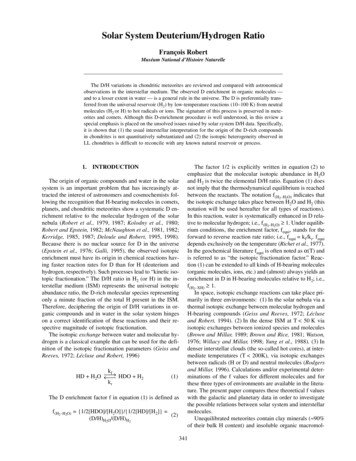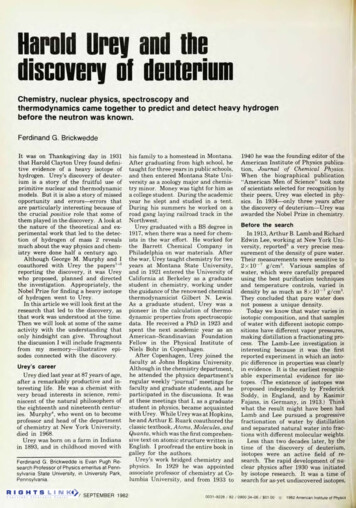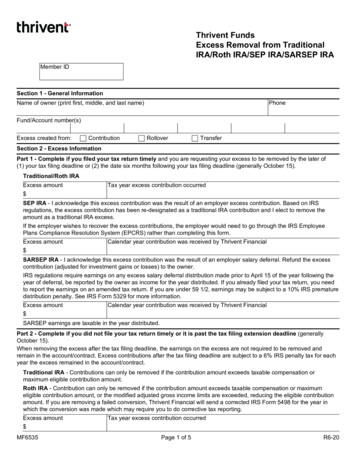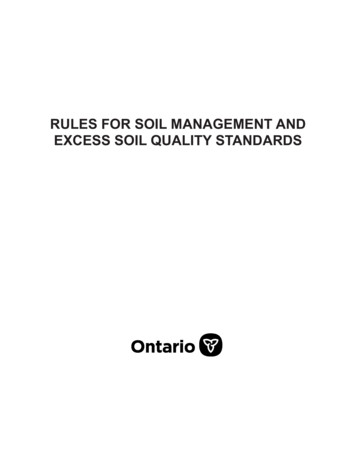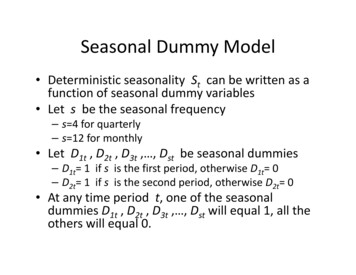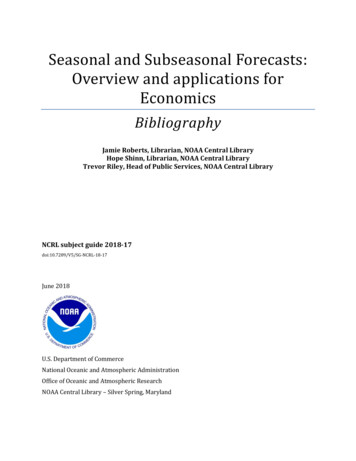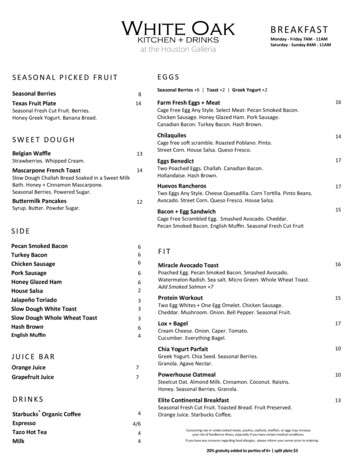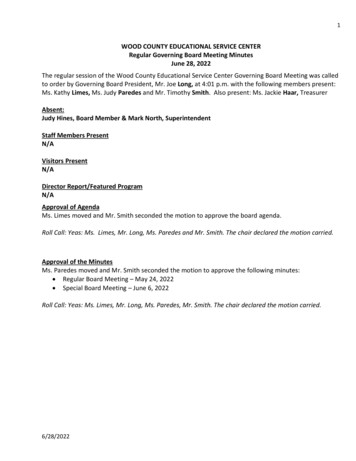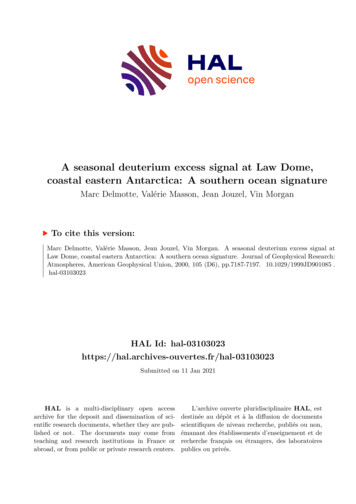
Transcription
A seasonal deuterium excess signal at Law Dome,coastal eastern Antarctica: A southern ocean signatureMarc Delmotte, Valérie Masson, Jean Jouzel, Vin MorganTo cite this version:Marc Delmotte, Valérie Masson, Jean Jouzel, Vin Morgan. A seasonal deuterium excess signal atLaw Dome, coastal eastern Antarctica: A southern ocean signature. Journal of Geophysical Research:Atmospheres, American Geophysical Union, 2000, 105 (D6), pp.7187-7197. 10.1029/1999JD901085 . hal-03103023 HAL Id: 3103023Submitted on 11 Jan 2021HAL is a multi-disciplinary open accessarchive for the deposit and dissemination of scientific research documents, whether they are published or not. The documents may come fromteaching and research institutions in France orabroad, or from public or private research centers.L’archive ouverte pluridisciplinaire HAL, estdestinée au dépôt et à la diffusion de documentsscientifiques de niveau recherche, publiés ou non,émanant des établissements d’enseignement et derecherche français ou étrangers, des laboratoirespublics ou privés.
JOURNALOF GEOPHYSICALRESEARCH,VOL. 105, NO. D6, PAGES 7187-7197, MARCH 27, 2000A seasonaldeuterium excesssignal at Law Dome, coastaleastern Antarctica: A southern ocean signatureMarc Delmotte,' Va16rieMasson,and JeanJouzelLaboratoire des Sciences du Climat et de l'Environnement (LSCE), UMR CEA-CNRS, Gif-sur-Yvette. FranceVin I. MorganAntarcticCRC stract. The snowisotopiccomposition(6 O and6D) of two shallowcoresfl'omthehighaccumulationsummitregion of Law Dome, eastAntarctica,was measuredat monthly resolutionoverthe 1980-1992period.Whilethe8 O or D euteriumexcess(d 8D-88 O) is shiftedwithrespectto 15t Ocycleby a 4 monthslag.Interpretationof this phaselag is investigatedusingboth an AtmosphericGeneralCirculationModel (AGCM), which includesthe water isotopiccycles,and a simpleisotopicmodel, whichbetterdescribesthe microphysicalprocesseswithin the cloud.Using this dual approach,we showthattheseasonalityof 8 O andd at Law Domesummitresultsfroma combinationof thesouthernoceantemperaturecycle (shiftedby 2-3 monthswith respectto the local insolation)andseasonalmoistureoriginchangesdue to a strongcontributionof the local oceanwhenice free.Both approachesare consistentwith a dominanttemperateto subtropicalmoistureorigin. We thusdemonstratefrom our present-daysubseasonalstudythat the recordof d in the Dome SummitSouth(DSS) deepice corerepresentsa potentialtool for identifyingchangesin SouthernOceantemperaturesand/orseaice coverat the scaleof the pastthousandyears.1. otopiccomposition( O or D expressedasper rail deviationversusStandardMean OceanWater (SMOW))measuredin ice coresis commonly usedto infer paleoclimaticinformationsuchas temperatureand accumulation[Ciais et al.,1994: Cuffey and Clow, 1997; Jouzel et al., 1987a, 1996].The combination of both isotopic species enables theinvestigation of a second-orderparameter, the deuteriumexcess(d)defined by the tollowing expression [Dansgaard,1964]d 8D - 8 * 8 ' O(1)The deuterium excess parameter reflects the differenta large role in determining the d composition of the polarprecipitation.Interpretationof polar snow deuteriumexcess using simpleisotopicmodels has shown that d is stronglydependenton thesea surface temperature (SST), relative humidity, and surfacewind speedof the oceanic moisture source [Ciais eta!., 1995;Johnsen et al., 1989; Jouzel and Merlivat,1984; Petit eta!.,1991]. The combinationof measuredand simulated(8 sO, d)data is thus a potential tool for the identification of majorcharacteristicsof moisture sourcescontributing to Antarcticprecipitation [Ciais et al., 1995; Petit et al., 1991]. In thispaper this approachwill be applied on a subseasonaltimescalefor the specificLaw Dome area.1.2.LawDomeSitebehaviorsof the two isotopic species(HDO and H2 aO)For more than 20 years, glaciological and climatologicalresearch programs have been conducted by the Australianfractionation.The deuterium excess is also sensitive to nonNational Antarctic ResearchExpeditions (ANARE) in WilkesRayleigh phase changes, such as the evaporation from theLand, easternAntarctica. A particularinteresthas been devotedocean or the formation of ice crystals inside a cloud. Duringto the Law Dome area, where several ice drillings werethese specific phase changes, the water isotopic moleculesperformed [B dd and Morgan, 1977; B cl, 1966; Morgan,undergoan additional nonequilibrium fractionation ("kinetic1979, 1985], including a recent deep drilling down to theeffect" as describedby Merlivat and Jouzel [1979]) resultingbedrock at the Dome Summit South (DSS) site near the summitt¾om differences in the diffusion coefficientsof the differentof the dome [Morgan et al., 1997].molecules. The kinetic fractionationenhances the differencesLaw Dome is a small ice cap about 200 km in diameteroccurringduring processessuchas Rayleigh-type equilibriumbetweenthefractionationof HDO andH2 SOandtherebyplays Now at Laboratoire de Gfiochimie et Cos nochimie, CNRS/IPGP, Pro'is.France.Copyright2000 by the AmericanGeophysicalUnion.located on the coast of East Antarcticaat 66ø46'Slatitude,112ø48'E longitude. The Law Dome summit area (1390 mabove sea level) gathers favorable conditions for isotopicstudiesbecauseof its (1) low mean annual temperature(-22øC)preventing summer melting, (2) large accumulation ratePapernu nber1999JD901085.(640 kg m-2yr- , 0.7 m of excellent temporal resolution, (3) moderate mean annualD901085509.007187
7188DELMOTIE ET AL.: SEASONAL DEUTERIUM EXCESS AT LAW DOMEsurfacewindspeed(8.3 m s' ) anda small horizontalflow at each5 cm. To complementthis and extendthe record, a secondthe summit of the dome ( 1 m an' ) excluding large core (DSS 92P) was drilled in January 1992, 200 m southwestof DSS 87P. For this 9.6 m long core, a different samplingdisturbancesin snow stratigraphy.All theseconditionsenable the preservationof well-marked method was adopted; in order to have a regular temporalseasonal cycles in the ice isotopic composition as well as sampling,7 cm sampleswere takenfrom zero to 2.72 m depth,other seasonalspecies[Delrnoneet al., 1999;Van Oremenand then 6 cm samplesfrom 2.72 to 8.01 m, and finally, 5 cmMorgan, 1996]. The existenceof these cycles also providesa samplesfrom 8.01 down to the bottom of the core. Eachfor (5 O and 6D at Laboratoiredestool to date the cores by counting the individual seasonal samplewas measuredSciencesdu Climat et de l'Environnement (LSCE) with a highcycles.In thispaperweuseb O andfid datameasuredin twofirn precision:0.5%0and 0.05%0for 6D [Vaughnet al., 1998] andcoresdrilled near DSS at the summit of Law Dome to study the 0[Dehnotte,1997]respectively,leadingto an accuracyofbetweenthedeuteriumexcessparameteron a subseasonaltimescale, with 0.7%0for d. Thereis a goodagreementthe aim of characterizingthe oceanicmoisturesourcefor the measuredin the two coresin the overlapping section duringLaw Dome area. The observed isotopic seasonal cycles are the period 1986-1988 (seeFigure 1), confirming the minimalinterpreted using both an atmospheric general circulation disturbanceof the layering by surfacesnow redistribution.The very clear seasonalcycles revealed by the isotopicmodel, including the water isotopic cycles, and a simpleisotopic model. This work representsa first-step analysis to records(seeFigure 1) enablea yearly dating,to be producedbytheseasonalcyclesin b 80(or bD). Furthermore,thethe interpretation of the full DSS deep ice core deuterium countingexcessprofile [Dehnotte, 1997] which coversthe last 10,000 use of the H,O, record[Van O nmenand Morgan, 1996]a prdciiedatingat a monthlyresolutionbecauseofyearswith a high resolutionduringthe early Holoceneperiod. providesthe strong dependencyof this signal to the intensity andspectraldistributionof the solarradiation[Neftel et al., 1986,2. Observations1995]. On the basis of this hypothesis, Van Oremen andMorgan [1996] associatedthe highestvaluesof peroxidewith2.1.Measurements and Age Scale:the summersolstice. The time lag between the maxima ofOur study is basedon more than 800 individual isotopic peroxide and the maxima of the ice isotopic compositionanalyses(6D and6 80) conductedon two shallowfirn cores places the isotopic maximum around mid-January, inlocatedin the vicinity of the DSS deepdrilling. The first core accordance with the temperature maximum from local(DSS 87P) was drilled in December 1987, 2 m away from the meteorologicaldata [Russell-Headand Simmonds,1993]. Themain DSS core. It is 12.4 m long and was sampled regularly temporal resolutionof our recordscovers a minimum of 2Date (Year)Figure 1. Isotopicrecords((5 80,6D, andd) theresultsfrom the Dome Summit South (DSS) PICO 1987 and the asterisksillustrate the results obtained from theDSS PICO 1992. The excessrecordhasbeensmoothedusing a running averageover three points to reducethehigh-frequencyvariability.The upper!.65 m of the DSS P87 corewasnot measuredfor deuterium(i.e., excess)astherewerenosamplesleftafter(5 Omeasurements.
DELMOTrE ET AL.: SEASONALDEUTERIUMEXCESSAT LAW DOME7189-5"-,, DSSPico1987 -MeanAWS( -20 -25 -30-140-oo -160o-180-200- - 18 ,. 22. --24 --26-286oo4o20I2 I4 6810 12141618202224MonthsFigure2. Meanseasonalcyclesof fiD,/5 O,andd (bottomcurves)at DSSdeducedfrombothfirn cores,asafunctionof months.Thetop curverepresentsthe meanannualtemperaturerecordoverthe 1986-1990periodobtainedfrom the automaticweatherstation(AWS) of DSS (I. Allison, personalcommunication,1997). In allcasestheyearlycyclehasbeenrepresentedtwicefor clarity,andtheerrorbarsindicatethe interannualstandarddeviation (lc ).
7190DELMOT'FE ET AL.: SEASONAL DEUTERIUMsamples per month. A direct comparison of the isotopicEXCESS AT LAW DOMEhighas 8%c,(similarto the amplitudein 5'SO).Theamplituderecordsof the two coreswith the meteorological data from theof the seasonalsignalsis fairly constantwith depth, since theLaw Dome automatic weather station (AWS) (available for theisotopic smoothing due to water vapor diffusion in the firn1991-1996 period, see Figure 2) shows good correlation (diffusion length of 8 cm [Van Oremen and Morgan, 1996])between the ice core data and the local temperature and has minimal effect because of the large accumulation. Thegood overlapping of the two cores between 1986 and 1988,confirmsthe validity of the datingmethodused.corresponding,respectively, to the bottom and to the upperpart of the 1992 and 1987 firn cores corroborates this2.2.Resultsminimum isotopic smoothing effect, The large oppositeThe isotopic records(8 sO, 15D,and c/) are shown in excess spikes revealed by the two cores between 1986 andFigure 1. Note that the d recordis presentedas a running mean 1987 remain unexplained, but the measurementshave beenaverage over three points, in order to reduce the high- checkedand are not in question.it is possibly linked with thefrequencyvariability. We!l-mark6dseasonalcyclesappearin very low density at the top of DSS 87P.the SD, 5 sO,andthed records.Thereis a smalloffset(I.2%o)Using a time normalizationof the averageisotopic signalsbetweenthe two excessrecordsresultingfrom similar shifts in [Ciais et ai., 1995] enables us to look carefully at the phase 5'sO(0.5%0)andfid (2.6%0)records.Suchdifferencesbetween relationshipbetween 5'SOandd. The averageseasonalcyclesadjacent cores are typical of isotopic deposition and arises of fid and 5 sO(seeFigure2) clearlyreflectthe seasonalityoffi'om modulationof the accumulationby the surfaceroughness the local surfaceair temperature,with an isotopic minimum inand by post deposition processes[White et al., 1997]. The winter (July-August)and an isotopic maximum during summer 5 sOshift observedat Law Domeis quantitativelyin good (January-February).The seasonality of d is shifted byagreementwith the observationsfrom the Arctic [Fisher et al., 4 months ( I month as illustrated in Figure 2), with a1985]. L2 w Dome region is characterized by very large minimum in late spring(November-December)and a maximumgradientsin elevation and accumulationrate. However, unlike occurringmost lYequentlyin !ate autumn(May-June). Usingeach isotopic specie (sensitive to elevation change), the either the raw ddata or the smoothed profile does not affectdeuteriumexcessis fairly constantall over the Law Dome area, this result. Interestingly, the phase relationship seemsas indicated by measurementsfi'om several firn and ice cores remarkably stable in time during the !ate Holocene, as revealedrepresentativeof the large range of elevation and accumulation by individual seasonal cycles measuredin the DSS deep iceratesencounteredin this region (Table 1). This result enables core at variousdepths(200, 400, 600, and 900 m covering theus to rule out the possibility of a geographical drift last 5000 years, not shown).responsible for the d shift.In a previous study Johnsen and White [1989] examinedThe mean amplitude of d as calculatedfi'om the raw data data fi'om Greenland and showed that at low altitudes d and 5 SOgenerally averagesat 5%0but occasionally reachesvaluesas were in phase opposition, while at higher elevations, there'Fable 1. GeographicDistributionof DeuteriumExcessOver the Law Dome Ice Cap As InferredFrom SeveralFirn and iceCores.Location.SiteTiine Period,,CoveredLatitude LongitudeElevationAccu nulationDome(m)( kg m'2yr' )Location SD 5 sOd'orNumberof Resolution , (%o) (% .)(% ,)MeasuretnentsDSS 87P66046 ' ! I"I 12ø48'25"1379640Summit1979-1987SS- 170.3-21.673. i uDSS 92P66046 ' 16"I 12ø48'25"1379640Summit1985-1992SS- ! 72.9-22.154.3DSS deep66046' I I"112ø48'25"1379640 Summit1742-1842:'A- 175.2 -22.393.9DEO8-266043'26"! 12ø48'25"12701979-1992SS- 159.05.2BHF66009'06"112048'25"113points9-144.1 -18.62 4.93601144eastern flank80 northwest-20.49coast"No deuterium measurementswere made on the upper part of the DSS deep ice core (bad ice cluality) and we then used the first 100 yearsof the isotopicrecordsto calculatethe meanvaluespresentedhere. ' The resolutionof the DSS deep ice core is annual(A) whereasfor DEO8-2 and the two tim cores it is subseasonal(SS). Due to theimportant flow disturbancesat BHF, no precise timescale was establishedfor this record [Budd and Morgan, 1977]. it is therefore difficult toassessthe resolution of this record, but the isotopic values tBr BHF arise from means of 7 core sections fi'o n the Holocene period (core sectionsare !.5 to 1.7 m long with a 10 cm samplingresolution). ' The experi nentaluncertaintiesfor õD and 5 sOineasurementsare0.5 and0.05%0,respectively,exceptfor BHF (0.15%ofor J sO).Thisleadsto an uncertaintyof 0.7 %0 for all d determination,except for BHF ( 1.3 %0). We have also estimatedthe temporal variability of d to be-0.6%0 by applyinga 13 year averagewindowto the first 150yearsof the DSS deepd record.' Withouttakin into accountthedeuteriumexcesspointsfromthe upperpartof the DSS 87P(negativespike),themeanexcessvalue wouldbe 3.2 instead of 3. I.
DELMOTTE ET AL.: SEASONAL DEUTERIUM EXCESS AT LAW DOMEwas a lag in d. Ciais and others [1995] reportedon the phasingof d and5D at SouthPole and D47 in Terre Adelie. They foundthat at D47, d was in phasewith 5D, while at South Pole, dlagged 5D by -5 months. The characteristicsof the D47(154øE, 75øS) and DSS sites are quite similar: a short distance7191source neteorologicai parameters (mainly SST but alsorelative humidity (h)and wind speed, (w))which affect theisotopic content of the first evaporatedvapor (150);(2) theseasonal change of moisture source;(3)the trajectory of themoisture and its phase changes history; this includestemperature, supersaturation, condensation,droplett¾omthe closest coast (around 100 km), a similar elevation(1400 m for DSS, 1550 n tbr D47), and similar average surfacete nperatures(-22øC for DSS and-25øC for D47). However, ourreevaporation,and rain-out history, which are affectedby thechemical composition of the atmosphere(aerosolsact as cloudcondensationnuclei), and the sea ice seasonal variability; and(4) the Law Dome seasonalcycle of condensationtemperatureresultsconcerningthe d-5D phaselag significantlydiffer fromthe one of D47. This difference could be at least partlyexplained becauseboth the dating and the stratigraphy are lesspreciseat D47, as a result of a smaller accumulation (typically3 times lower than for DSS) and of the very strong winds:and accumulation.All theseprocessesare fully representedwithin the atmospheric general circulation model (AGCM) apart from theimpact of the atmospheric aerosol load on condensation.Delaygue et al. [1999] have shown that even at this lowhorizontal resolution, the GISS model captures many featuresof nodern Southern Hemisphere and Antarctic hydrologicalcycle. Because of the limited horizontal resolution of the(annualaverage 1lm s-', [Allison et al., 1993]) whichprobably significantly alter the snow stratigraphyat that site.Last, one might note that these two coastal sites differ by 10ø n their latitudinal position, Law Dome being furthernorthwardand subjectto larger maritime influence. nodel, the area between 70øS and 60øS latitude,110øE and120øElongitude is consideredto be representativeof the Law3. Modeling and DiscussionDonneregion (two model grid points). We show that despite itsTo understandthe processesresponsible for the observed low resolution the GISS model is able to simulate realisticisotopic seasonality at Law Dome, we have used the NASA seasonalfeaturesof Law Dome water isotopes,and we estimateGISS atmosphericgeneralcirculationmodel (with a horizontal the seasonalchange in moisture origin. We then use a simpleresolution of 8ø by 10ø), version II [Hansen et al., 1983], inisotopic model to evaluate the relative impact of moisturewhich the water evaporating t¾omvarious sourceareascan be sourceseasonal cycles versus moisture origin seasonal cycletagged [Koster et al., 1986, 1992] and which includes the on the excessseasonalcycle. A comparisonof the two modelmodeling of water isotopes. A 1979-1988 simulation was analysis procedures used in our study is summarized inperformed(the first 2 years of the simulation were considered Figure 3.as spin-up time).The AGCM-simulatedannualmean5 aOis slightlytoo highThe phaserelationshipbetween 80 (or fiD) andd at Law (-19.0%o versus-21.8%o observed),and the amplitude of theDome is driven by physical processesaffecting phase changes seasonal cycle is overestimated by about one third (6.4%0and isotopic fractionations:(I) the seasonal cycle of moisture versus 4.7%0 observed). This is consistent with the simulationGISSAGCMOUTPUTINPUTS10-year-longglobal ervedSSTstratiform convective ,fiD,d .)ateach modelgrid pointmultiplecondensationevaporationprocessesalong thecloud trajectoryINPUTSObservedSST:MCIMfor eachsinglemoisturesource(latitudinalaverage)- one run for each moistureInitial vapour(8 SO,fiD):source and each month- from GISS output- or from closureequation- shortest(zonal) air masstrajectoryOUTPUT(b 80,bD, d) at Law Domefor each moisture source andeach month- stratiform cloudLaw Dome (T, P)- from GISS outputmicrophysics ,,.- or from observationsFigure 3.Comparativeschemeof the two numericalmodelsusedin this study, the GISS AGCM and thesimple isotopicmodel (MCIM). For both models,the main inputs, outputs,and characteristicsare presented.
E86oo246810-12141618202224Months MC M( CM)MCIM (closore equation)DSSPICO87-14--I-22: :!-24\-26.ß --*-28,2 4I6\/I",,\:4,8/ , -*-,10,1214!16,\I18/,/!"I20,I22,24MonthsFigure4. Comparisonof themonthlymean 5" Oanddeuteriumexcessasobtainedfromthe MCIM es),fromthe MCIM withthe GISSinitialization(mixedß mthedataof DSSPICO87(asterisks).
33OEquatorialOcean TropicalOcean25- 2O15SubglacialOcean10Mean originTemperate Ocean -5-10-15Gladal Ocean-2O3300315030002850,,727006543210-20-,-22' ''-L -24-26t-I ß ' I'24['6I'8II I'101214161820'2224MonthsFigure 5. Deuteriumexcessand{5 SOseasonalcyclesassimulatedby ualvariability.Onthetopof omearerepresented(seecaptionofFigure7 forthesourcezonedefinition).Theseasonalcycleof theseaiceoffshoreLawDome,at dicatestheseaiceextent. Its interannualstandarddeviation is typically 50 hefirst6observed)andan overestimationof their elast6 months(30øCversus16øCobserved).Genthon[1994] hasrelatedthis monthsof too warm local surfacetemperatures(2.5øC higher thanclimaticbiasto the %o),in fair agreementwith the observations4 and5). Withinthislargeinterannualvariabilitythephasingof theGCMsurfacetemperatureand 5 SOseasonal(Figurescycleis, however,in goodagreementwith the observationssimulatedseasonalityis similar to the one obtainedfrommeasurements(3-4 monthsphaseshiftbetweend and(Figure4). Althoughslightlytoo highon average(5.0%o isotopicversus3.8% observed),the simulatedexcessseasonalcycleemergesasa y from
7194DELMOTTEET AL.' SEASONALDEUTERIUMthe Indian Ocean sector and is transported poleward by thezonal circulation in the tropics and subtropicsand then morelongitudinally in the high latitudes (Figure 5). Thesubtropical, temperate, and southern oceans (see caption ofFigure 5 for detailed definition) provide more than 80% of thesimulatedprecipitation. Becauseof the oceanthermal inertia,each of these oceanic regions (moisture sources) ischaracterizedby a SST seasonalcycle shifted with respect tosouthern insolation, with a temperature maximum in latesummer-autumn and a minimum in late winter-spring.However, the seasonality of the moisture origin is dominatedby the contribution of the local Southern Ocean whichincreasesin summer (more than 35% of the total precipitation)and decreasesin winter (less than 10%), reflecting the sea iceseasonality(Figure 3).To better understandthe role of seasonal moisture origin(Figure 4) and the role of the seasonality at each moisturesourceon the isotopic signals, we have performedadditionalsimulations with a simple isotopic model (mixed cloud isotopic model, MCIM) developed by Ciais and Jouzel [1994],following the Rayleigh-type distillation modelsof Dansgaard[ 1964], Jouzel and Merlivat [ 1984], and Merlivat and Jouzel[1979]. This simple model considers an isolated air massmoving polarward from a prescribedwater evaporation sourceto a prescribedprecipitation location and accounts for thecloud microphysics processes(Figure 3). The seasonality ofthe moisture source meteorological variables will onlyimprint the isotopic composition of the first evaporatedmoisture051 ).In principle,theMCIM shouldbe forcedbymodern observations,which is not possible dueto the lack ofvapor isotopic compositionmeasurements[Craig and Gordon,1965]. It is therefore necessary to prescribe or parameterize 50whichis onemajorsourceof uncertaintiesforthesimpleEXCESS AT LAW DOMEmodelresults[Jouzeland Koster, 1996]. In a first approach, 50can be calculated from the oceanic climatic parametersbyassuminga closed systemand a local isotopicbalance betweenthe precipitation and the evaporation (the so-called closureequation[Merlivat and Jouzel, 1979]). Alternatively, the 50simulated by an isotopic AGCM can be prescribedto thesimple model, since the AGCM computes the exchangeprocesses taking place at the ocean-atmosphere interface[Jouzel et al., 1997' Jouzel and Koster, 1996]. These twoapproacheshave to be comparedas they may lead to different 5 seasonalcycles.The MCIM also has to be prescribedto the precipitationsite temperatures;two approacheshave been compared:usingthe Law Dome AWS observations (I. Allison, personalcommunication,1997)or the GISS AGCMcondensationtemperatures. Altogether, four different simulations wereperformedtbr each month, each moisture source(five distinctsources): two approaches tbr the initial moisture (closureequation from observed SST and GISS relative humidity andwind speedversusGISS vapor isotopic composition) and twoapproachesfor the site temperature(observed local inversiontemperature versus GISS condensation temperature).Sensitivity experiments conductedwith three other AGCM(LMD5.3, GISS II andECHAM3) showthatthe initial isotopiccomposition 8o calculatedusing the different AGCM outputs(h, w) and the closureequationare almost independentof theGCM used [Delmotte, 1997]. For each of the four combinedapproaches, we obtain simulations of Law Dome isotopicseasonal cycles fi'om each moisture source. Using the GISSmoisture origin diagnostic (Figure 6), we also weigh theresultsfi'om each moisturesource by its monthly contribution(hereinafter referred to as mixed origin). This enables toseparate the relative impact of the moisture source seasonal100%80%60%r Equatorial Oceanr Tropicai Oceanr Subtropical OceantaTemperate Ocean4O% aSouthernOcean20%0%123456789101112MonthsFigure 6. Monthly origin of the precipitation at Law Dome simulated by the NASA/GISS AGCM. Thestandarddeviation can be as high as 5 to 10% for southern,temperate, and subtropical origins during theirrelative maximum of amplitude.
DELMOT'FE ET AL.: SEASONAL DEUTERIUM EXCESS AT LAW DOME2O -2O15151010. 'o * V ' . ., '-'.' ' . & --, ' ' ' '"'0""- -E .'"Et'EI" I"o' j3.-E ' - ., .-107195 . -" - :25 - - 'a"'O'"'[g ' .- : 4 o o 2 4 o,-102o2222446810-5[141618202224dfI' .-30 L12MonthsMonths: '' .":: :::.x','. "' . ':'. .ß.0-30 -35-25 : ,z,. ' .a. .'.,.: ' ., .-- .'.o-25""I,I.':.".'''.''t-35-40-40-45-45-50[,I . I I I I t I,248810 2 4J, 8I, 8I,20I 22-502244681012141618202224MonthsMonthsFigure 7. Simulationsof the seasonalvariationsof 8" Oandd at DSSwiththe MCIM for variousmoistureoriginswhenthe initial vaporcompositionis takenfromthe GISSsimulation(b, d) or calculatedfrom theclosureequation(a, c). inalandSSTconsiderations.(I) SouthernOcean:crosses,latitudebetween60ø and75øS,meanannualSST 0øC(fixed to -1.8øC betweenMarchandNovember);(2) temperateocean:opendiamonds,latitudebetween45ø and60 øS,meanannualSSTbetween-I ø and 12øC;(3) subtropicalocean:opensquares,latitudebetween30ø and45øS,meanannualSSTbetween8ø and22øC;(4) tropicalocean:opencircles,latitudebetween15ø and30øS,meanannualSSTbetween20ø and27øC;(5) equatorialocean:full triangles,latitudebetween0ø and15øS,meanannualSST 24øC;(6)mixedorigin: full circles,weightedmoistureorigin accordingto their relativecontributionof Law Domeprecipitation(compareFigure 6).cycle from the impact of moistureorigin, which cannot bedone for the GCM.When the MCIM is run with input parametersconsistentwith the GISS simulation (Figures 7b and 7d), the resultingmixed origin isotopes show a phase relationship similar tothe AGCM (/5'SOminimumin July andd maximumin April).However,the annualmeanvalueof/5'SOis too low by 3%0,theexcesstoo high by 0.5%c,,andthe amplitudeof theseasonalcycle is overestimatedby about2.3%c,(one third). Itis not possible to simulateexactly the resultsof the AGCMwith the MCIM due to several factors: (1) the MCIM does notsurfacecharacteristicsaveragedover each oceanic zone, anddoes not aim at simulating individual precipitating events asthe AGCM; (4) largeuncertaintiesexistin the initialization ofthe MCIM in the partly sea ice-coveredregions (SouthernOcean at freezing temperature), and (5) the MCIMmicrophysicalparameterizationsare differentfrom the AGCMones(samesupersaturationfunctionbut differentprecipitationschemes).Taking into accountthe observed site temperatureversusthe GISS-simulatedtemperatureonly leadsto an offsetin the isotopicmean values (not shown).The MCIMsimulates a maximum in excess between Marchtake into account the convective processesthat are importantin the vicinityof Law Dome dueto the storm track trajectoriesand the relatively low latitudeof this site in Antarctica; theAGCM simulates a strong contribution of the convectiveschemeto the precipitationand a strong isotopic signatureofthis convective activity (not shown); (2) the MCIM doesnottake into accountthe trajectories of the air mass and is runwith a direct zonal idealized moisturetransport; (3) the MCIMandApril for eachmoisturesource;the mixedsourceseasonalcycle thereforedirectly reflects the seasonalcycle of eachis run l¾om monthly mean values without variability, forAGCMindividual moisturesource(Figures7a and 7c). Dependingonthe MCIM inputs, one single moisture source(temperate orsubtropical)can explain the observedmeanvaluesand phaserelationshipsof the Law Dome isotopes.Indeed, the temperateand subtropicalregions (annualmean SST between-I and 22øC)provide70% of Law Dome precipitation in the GISSsimulation.
7196DELMOTFE ET AL.: SEASONAL DEUTERIUM EXCESS AT LAW DOMEHowever, using the closureequationto initiate the isotopiccompositionof the first vapor has a large impact on the modelresults and leads to very low and unrealistic d values for themixed origin (negative annual mean d in Law Dome precipitation). Moreover, the seasonal cycle of d from each individualmoisturesourceis thistimemuchweakerandis formostsourcesmaximum in Jan
Paper nu nber 1999JD901085. 0148-0227/00/1999J D901085509.00 1.2. Law Dome Site . seasonal cycles in the ice isotopic composition as well as other seasonal species [Delrnone et al., 1999; Van Oremen and . Measurements and Age Scale: Our study is based on more than 800 individual isotopic analyses (6D and 6 80) conducted on two shallow .
